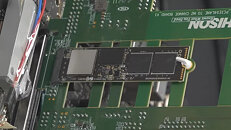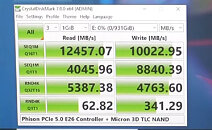Raevenlord
News Editor
- Joined
- Aug 12, 2016
- Messages
- 3,755 (1.18/day)
- Location
- Portugal
| System Name | The Ryzening |
|---|---|
| Processor | AMD Ryzen 9 5900X |
| Motherboard | MSI X570 MAG TOMAHAWK |
| Cooling | Lian Li Galahad 360mm AIO |
| Memory | 32 GB G.Skill Trident Z F4-3733 (4x 8 GB) |
| Video Card(s) | Gigabyte RTX 3070 Ti |
| Storage | Boot: Transcend MTE220S 2TB, Kintson A2000 1TB, Seagate Firewolf Pro 14 TB |
| Display(s) | Acer Nitro VG270UP (1440p 144 Hz IPS) |
| Case | Lian Li O11DX Dynamic White |
| Audio Device(s) | iFi Audio Zen DAC |
| Power Supply | Seasonic Focus+ 750 W |
| Mouse | Cooler Master Masterkeys Lite L |
| Keyboard | Cooler Master Masterkeys Lite L |
| Software | Windows 10 x64 |
Phison has showcased the expected performance of its upcoming PS5026-E26 controller, built to usher NVMe SSDs into the PCIe 5.0 realm. The company showcased its new controller's prowess by building a reference SSD design based on 1 TB of Micron's TLC NAND. Phison's new controller has been built from the ground-up to accelerate next-generation SSD workloads - including direct access technologies based on Microsoft's DirectStorage API, accelerated by two ARM Cortex-R5 cores and three proprietary CoXProcessor 2.0 accelerators built on TSMC's 12 nm process.
Phison's internal testing shows its reference SSD achieving sequential read speeds of over 12 GB/s in CrystalDiskMark, with sequential writes going as high as 10 GB/s - a 70% performance increase compared to the world's fastest PCIe 4.0 SSDs, which currently top out at around 7 GB/s sequential speeds. As to 4K performance, one of the most tangible metrics for user experience, random reads are set at around 16.000 IOPS, showcasing room for improvement with further firmware optimizations for actual shipping products.


Interestingly, Phison opted for the M.2 2580 form-factor for its proof-of-concept SSD, which features a slightly wider PCB and connector footprint that's not backwards compatible with M.2 2280 slots. Expect SSDs based on Phison's PS5026-E26 controller to hit the market later this year - closer to AMD's release of its 600-series chipsets for its next-generation AM5 platform.
View at TechPowerUp Main Site | Source
Phison's internal testing shows its reference SSD achieving sequential read speeds of over 12 GB/s in CrystalDiskMark, with sequential writes going as high as 10 GB/s - a 70% performance increase compared to the world's fastest PCIe 4.0 SSDs, which currently top out at around 7 GB/s sequential speeds. As to 4K performance, one of the most tangible metrics for user experience, random reads are set at around 16.000 IOPS, showcasing room for improvement with further firmware optimizations for actual shipping products.


Interestingly, Phison opted for the M.2 2580 form-factor for its proof-of-concept SSD, which features a slightly wider PCB and connector footprint that's not backwards compatible with M.2 2280 slots. Expect SSDs based on Phison's PS5026-E26 controller to hit the market later this year - closer to AMD's release of its 600-series chipsets for its next-generation AM5 platform.
View at TechPowerUp Main Site | Source










